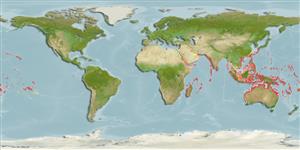>
Acanthuriformes (Surgeonfishes) >
Acanthuridae (Surgeonfishes, tangs, unicornfishes) > Acanthurinae
Etymology: Acanthurus: Greek, akantha = thorn + Greek, oura = tail (Ref. 45335).
More on author: Forsskål.
Environment: milieu / climate zone / depth range / distribution range
Écologie
marin récifal; non migrateur (Ref. 56001); profondeur 0 - 25 m (Ref. 48637), usually 2 - 25 m (Ref. 27115). Tropical; 24°C - 28°C (Ref. 27115); 31°N - 34°S, 3°E - 123°W
Indo-Pacific: Red Sea south to Transkei, South Africa (Ref. 3145) and east to the Hawaiian and Tuamoto islands, north to southern Japan, south to the southern Great Barrier Reef, New Caledonia, and Rapa (Austral Islands).
Length at first maturity / Taille / Poids / Âge
Maturity: Lm 12.0, range 10 - 14 cm
Max length : 21.0 cm TL mâle / non sexé; (Ref. 30573)
Épines dorsales (Total): 9; Rayons mous dorsaux (Total): 24-27; Épines anales 3; Rayons mous anaux: 22 - 24. Brown in color when preserved; with or without fine bluish gray longitudinal lines on body; pale pectoral fins with upper edge narrowly black; pelvic fins brown. Lips blackish brown; median upper teeth tend to be pointed. Dorsal fin base with a prominent black spot larger than 1/2 eye diameter; a smaller spot on base of anal fin. Groove of caudal spine encircled with a narrow black margin. Gill rakers on anterior row:20-24; on posterior row:18-23.
Found on hard substrates of shallow lagoon and seaward reefs from the lower surge zone to a depth of more than 15 m (Ref. 27825). Benthopelagic (Ref. 58302). Feed on filamentous algae. Form spawning aggregations (Ref. 27825, 48637). Adults usually in small groups, but form large schools in some oceanic locations. Juveniles are often seen in mixed species aggregations (Ref. 48637). Species at the bottom of the 'pecking order' among surgeon fishes, and as a result employs the strategy of feeding in large schools that overwhelm the territorial defenses of other herbivores (Ref. 1602). Caught with nets (Ref. 30573). Can be eaten both raw and cooked (Ref. 7364). Maximum depth reported at 25m (Ref. 027115)
Life cycle and mating behavior
Maturité | Reproduction | Frai | Œufs | Fécondité | Larves
Form spawning aggregations (Ref. 27825).
Randall, J.E., 1956. A revision of the surgeonfish genus Acanthurus. Pac. Sci. 10(2):159-235. (Ref. 1920)
Statut dans la liste rouge de l'IUCN (Ref. 130435)
Menace pour l'homme
Reports of ciguatera poisoning (Ref. 31637)
Utilisations par l'homme
Pêcheries: commercial; Aquarium: Commercial
Plus d'informations
RéférencesAquacultureProfil d'aquacultureSouchesGénétiqueElectrophoresesHéritabilitéPathologiesTraitementNutrientsMass conversion
Outils
Articles particuliers
Télécharger en XML
Sources Internet
Estimates based on models
Preferred temperature (Ref.
123201): 24.6 - 29, mean 27.7 °C (based on 938 cells).
Phylogenetic diversity index (Ref.
82804): PD
50 = 0.5000 [Uniqueness, from 0.5 = low to 2.0 = high].
Bayesian length-weight: a=0.02512 (0.02049 - 0.03079), b=2.96 (2.92 - 3.00), in cm total length, based on LWR estimates for this species (Ref.
93245).
Niveau trophique (Ref.
69278): 2.0 ±0.0 se; based on diet studies.
Résilience (Ref.
120179): Milieu, temps minimum de doublement de population : 1,4 à 4,4 années (K=1.00-1.72; tm=2).
Fishing Vulnerability (Ref.
59153): Low to moderate vulnerability (27 of 100).
Nutrients (Ref.
124155): Calcium = 84.4 [37.2, 254.5] mg/100g; Iron = 0.908 [0.345, 2.248] mg/100g; Protein = 18.1 [16.9, 19.3] %; Omega3 = 0.105 [0.048, 0.228] g/100g; Selenium = 16.6 [5.8, 50.9] μg/100g; VitaminA = 42 [10, 168] μg/100g; Zinc = 3.34 [1.04, 6.25] mg/100g (wet weight);
